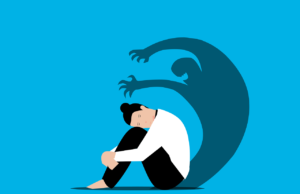Some anxiety in our lives can be productive, as it drives us to prepare for what lies ahead, thus enhancing our performance, say at school or work. But as we all know, anxiety can vary in the frequency with which it assails us, and its severity, ranging from mild to moderate or high levels, some of which can be debilitating.
I would like to differentiate between anxiety and panic attacks.
Like a flash flood, panic attacks can occur as if “out-of-the-blue” when you experience a rush of fear—either when already feeling somewhat anxious or even if completely relaxed. This panic is accompanied by thoughts of an imminent catastrophe (e.g., “I am dying”, “I am losing my mind”). Panic attacks peak quickly and decrease within 10-30 minutes, although some residual anxiety may remain for a while. The panic may return and one may then experience yet another episode of abrupt and extreme discomfort and fear.
Anxiety builds more slowly, for example, you start worrying about something in the future (e.g., the end-of-year evaluation at work, an important exam or presentation). When we expect that something bad or threatening may happen, our reaction of anxiety is our way of preparing to meet the challenges posed by these threats (e.g., physical, mental, social).
Most of us feel anxious or even panic at some point in our lives.
***
In order to become aware of how pervasive your anxious thoughts can be, it is helpful to learn how to observe and record them objectively, as though you were your own personal scientist—in a non-judgemental and objective way.
You may begin by noticing how often you feel anxious, how you experience your anxiety (e.g., accompanying thoughts, feelings, physical sensations and images, behaviors), what triggered the anxiety in the first place, how long these experiences last, and last but not least, what helped you calm down and whether you were alone at the time or with others.
For example, do the anxious feelings and thoughts come up when you are alone, upon having a stressful day at work or on your day off, in the morning or as night falls, when you visit a crowded shopping mall or are home alone, etc. Moreover, what helps you snap out of it, even if only for a short while, is valuable to know, because if it helped you once, it may help you again. So it pays to be increasingly aware of your inner fluctuations, and your anxiety level.
In essence you are monitoring how the anxiety or panic attack began, what it consisted of and how you experienced it, and how it ended— in other words, its beginning, middle and end. There are various advantages to this kind of record-keeping.
First, rather than passively enduring the anxiety, you become an active observer— the first step toward gaining control. Secondly, monitoring and knowing what you think, feel, or do, should make it easier to make some future changes in these areas. For example, you may be able to challenge a negative thought you are having about yourself—once you know what it is, you can take issue with it, answer back. Lastly, once you realize that your anxiety is not pervasive, and that there are other moments during the day and week where you feel more yourself, it becomes easier to gain some perspective about what worries you. As you begin to notice that your mood fluctuates, is not static but rather, dynamic, there is hope on the horizon. It is helpful to become consciously aware of the natural rhythm, the back and forth movement between anxiety (and sensations of constriction, such as a tightness in your throat) and a modicum of optimism (sensations of expansion, more air coming in).
It is best to jot down your experiences as close to the actual experience as possible, while still fresh on your mind. If you are busy at work or driving somewhere, it may have to wait. If you wish, you can download some forms for future use from this website (e.g., Brief Mood Survey (Burns); Panic Attack Record (Barlow & Craske)). You can also keep a record of your general feeling during the day, using a 10-point scale to rate your daily levels of anxiety and depression
(e.g., feeling “down” or “blue”, lacking in energy); how much you worry about having a future panic attack (which feels different from anxiety.) You can then track yourself over time, and measure your progress, especially if you utilize either self-help techniques and/or seek professional help.
What to look out for, track and record (the beginning, middle and end)
Trigger/s:
“I heard that my colleague got a bad evaluation and was subsequently fired.”
What you experience:
Sensations:
“I can feel my heart pounding and have shortness of breath.”
Images:
“My heart feels like in a vice. My neck is taut like a drum skin.”
Behavior:
“I find myself pacing about, biting my nails, even pulling out my hair.
What am I waiting for, I need to go to the ER!”
Affect/emotions:
“I’m afraid I shall go mad.”
Meaning/thoughts:
“What is wrong with me! “
“I worry about what my boss will say about my having missed work the other day. We have an important deadline to meet. I am toast.”
These various channels may reinforce each other in a negative cycle.
For example, a physical symptom (e..g., a racing heart) may lead to a thought
(“I may be having a heart attack”); this thought will increase the heart palpitations, leading to more catastrophic thoughts (e.g., “I will never make it to the ER.”).
Anxious behavior, such as pacing will increase tension, which in turn may lead to fear (an affect or emotion) more anxious thoughts etc.
How you calm down
“I remembered how successful my last project was.”
(accessing an internal resource of past success).
“I told my partner and she reassured me that whatever happened, she was there for me.”
(the calming effect of social engagement).
“A racing heart does not necessarily mean anything is physically wrong.”
(contesting the automatic negative thought).
“My nervous system is psyching up to prepare for action and deal with the threat.” (utilizing a working knowledge of how the body/nervous system operate, to understand what is happening).
Frequently Asked Questions
All of us have experienced anxiety at one time or another, especially now, with the advent of the corona virus. Anxiety may be viewed as being on a continuum, from mild to moderate and severe, and it may last seconds, minutes, days, weeks, and sometimes months.
Anxiety is an intense emotional state, characterized by feelings of unpleasant anticipation of impending danger, and accompanied by physiological arousal.
But how do you actually know you are feeling anxious? Where in your body do you feel it? What is the physical sensation at that particular moment?
What is your breathing like? Is your heart palpitating? Is there a fluttery feeling, like butterflies in your stomach? Is there tightness or constriction?
It is helpful to be able to locate where in your body you feel the anxiety, and to make an effort to describe its “felt sense” and how you feel at that particular moment.
In addition to their location in the body, physical sensations may have a shape or size, or even a color, and they are characterized by specific qualities e.g., constriction, tightness, spaciousness, temperature such as hot or cold, vibration, tingling.
Being able to localize and describe the sensations that comprise your anxiety is an important first step in managing it.
People may fear anything and everything, since this fear is often exaggerated and thus irrational. We may distinguish among: phobias regarding specific things (e.g., a fear of snakes or flying); a generalized state of anxiety; anxieties involving specific contents (e.g., separation anxiety, social anxiety, fear of contamination, of gaining weight); and post traumatic stress disorder.
Oftentimes, the above fears cover or mask deeply held fears, such as fear of annihilation or danger to one’s very existence, the fear of loss of love, fear of death).
In additon to worry and anxiety, some of the following symptoms may be present:
* restlessness and a sense of “being on edge”
* tiring easily
* physical or bodily tension, including muscular tension
* difficulty sleeping (falling asleep, remaining asleep, non-satisfying or restorative sleep)
* Irritability
* concentration difficulties, a sense of “black out”
Additional symptoms that may manifest themselves:
* shallow breathing or hyperventilation
* lack of self-confidence and self-doubts
* discomfort in social situations
* a tendency to postpone things
* decreased input
* catastrophic thinking (e.g., default of “worst case scenario”)
* panic
A sense of discomfort or fear may be accompanied by several of the following:
* difficulty breathing, a sense of being smothered or choking
* heart palpitations
* discomfort or pain in the chest
* abdominal distress or nausea
* a sense of instability, dizziness, fainting
* sweating
* heat waves or a sense of cold
* trembling and shaking
* a sense that what is happening is not really happening (derealization) or a sense of distance or dissociation from oneself (depersonalization).
* a lack of sensation, tingling
* a fear of losing control or one’s sanity
* a fear of death and dying
Many factors may contribute to the presence of anxiety, although it is not always possible to identify the relevant ones with certainty.
These include:
* a physiological cause, such as the use of various substances e..g., cannabis, drugs, medication.
* a general medical condition thought to directly influence anxiety via physiological mechanisms, such as hyperthyroidism.
* environmental factors, including the human environment
* biological or genetic factors
In addition to pharmacological interventions via medication and nutrition, various things may help. These include:
* nurturing relationships with significant others that can contain us without becoming overwhelmed
* getting enough sleep
* emotional first aid to learn how to self-regulate
* psychotherapy (such as Eye Movement Desensitization Reprocessing or EMDR, Cognitive Behavioral Therapy or CBT, dynamic psychotherapy)
* body-mind psychotherapy (such as Somatic Experiencing or SE)
* Yoga and Chi-gong
* Martial arts (such as Tai Chi)
* Sports











